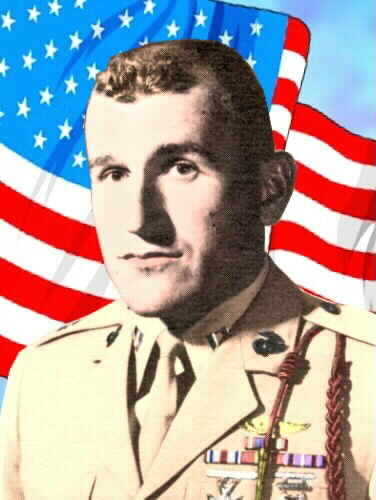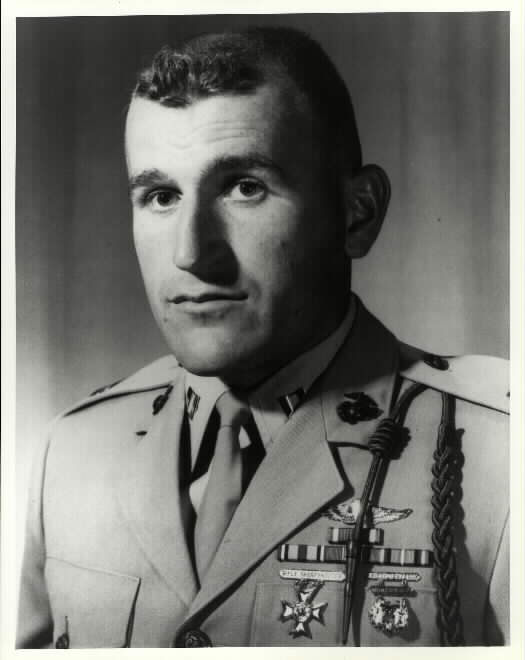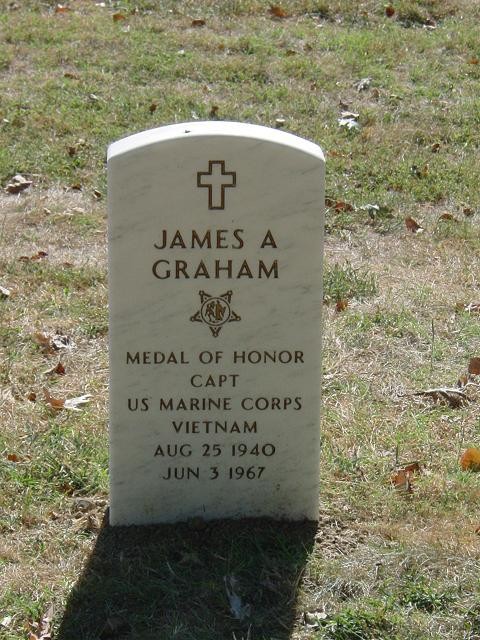Born at Wilkinsburg, Pennsylvania, August 25, 1940 he attended high school in Brandywine, Maryland, and received a BA degree in mathematics from Teachers College in Frostburg, Maryland, June 1963. Prior to enlisting in the Regular Marine Corps, he was a member of the U.S. Army (1955-57), the District of Columbia National Guard (1959-61) and the Army Reserve (1961) and the Marine Corps Reserve (1961-63).
He was discharged from the Marine Corps Reserve in order to accept a commission in the Marine Corps, September 30, 1963. He attended Officers Candidate School, USMC Schools, Quantico, Virginia, and was commissioned a Second Lieutenant, November 1, 1963. After completing OCS, he attended the Basic School at Quantico in December. He then commenced Naval Air Basic Training at the Naval Air Station, Pensacola, Florida, graduating in November 1964.
In January 1965, he was transferred to the 3rd Battalion, 6th Marines, 2nd Marine Division, Fleet Marine Force, Camp Lejeune, North Carolina, where he served consecutively as a Platoon Commander of Company I, Executive Officer of headquarters and Service Company, and Commanding Officer of Company M. During this period he participated in Santo Domingo, Dominican Republic Expedition to protect the lives of Americans during the uprising there in April-June 1965. While stationed at Camp Lejeune, he was promoted to First Lieutenant, May 1, 1965, and to Captain, September 1, 1966.
In November 1966, he joined 2nd Replacement Company, Staging Battalion, USMC Base, Camp Pendleton, California, for transfer to the Far East, Republic of Vietnam. Upon arrival in South Vietnam the following month, he joined 2nd Battalion, 5th Marines, 1st Marine Division (Reinforced). He first served as Commanding Officer of Company H until January 1967, then as Commanding Officer of Company F, January 2, 1967, during Operation Union II at Quang Tin, he chose to remain with one of his men who could not be moved due to the seriousness of his wounds, and was himself mortally wounded.
He received the Medal of Honor, the Purple Heart, Armed Forces Expeditionary Medal, Presidential Unit Citation, Navy Unit Commendation, National Defense Service Medal with one Bronze Star and the Republic of Vietnam Campaign Medal.
He was survived by his wife, Janice Graham and two children, John C. (born April 11, 1963) and Jennifer (born August 19, 1964). He was subsequently buried in Section 13 of Arlington National Cemetery.
Captain James Albert Graham, who was posthumously awarded the Medal of Honor for heroism in Vietnam in June 1967, was born August 25, 1940, in Wilkinsburg, Pennsylvania. He went to high school in Brandywine, Maryland. He received a B.A. degree in Mathematics upon graduation from Teachers College, in Frostburg, Maryland, in June 1963.
Prior to enlisting in the regular Marine Corps, he was a member of the U.S. Army (1955-57), the District of Columbia National Guard (1959-61), the U.S. Army Reserve (1961), and the U.S. Marine Corps Reserve (1961-63). He was discharged from the Marine Corps Reserve to accept a regular appointment in the Marine Corps, September 30, 1963.
He then attended the Officers Candidate Class, Marine Corps Schools, Quantico, Virginia, and was commissioned a second lieutenant, November 1, 1963.
After completing Officers Candidate Class in December, Lieutenant Graham commenced naval air basic training at the Naval Air Station, Pensacola, Florida. He then attended The Basic School, Marine Corps Schools, Quantico, graduating in November 1964.
In January 1965, he was transferred to the 3d Battalion, 6th Marines, 2d Marine Division, Camp Lejeune, North Carolina, and served consecutively as a platoon commander of Company I, Executive Officer of Headquarters and Service Company, and Commanding Officer of Company M. During this period, Lieutenant Graham participated in the Santo Domingo, Dominican Republic expedition to protect the lives of Americans during the uprising there from April until June 1965. While stationed at Camp Lejeune, he was promoted to first lieutenant, May 1, 1965 and to captain, September 1, 1966.
In November 1966, he joined the 2d Replacement Company, Staging Battalion, Marine Corps Base, Camp Pendleton, California, for transfer to the Republic of Vietnam. Upon arrival in South Vietnam the following month, Captain Graham joined the 2d Battalion, 5th Marines, 1st Marine Division. He first served as Commanding Officer of Company H, until January 1967, then became Commanding Officer of Company F. While in command of Company F on June 2, 1967, during Operation Union II at Quang Tin, Captain Graham chose to remain with one of his men who could not be moved due to the seriousness of his wounds, and was mortally wounded.
A complete list of his medals and decorations includes: the Medal of Honor, the Purple Heart, the Presidential Unit Citation, the Navy Unit Commendation, the Organized Marine Corps Reserve Medal, the National Defense Service Medal, the Armed Forces Expeditionary Medal, the Vietnamese Service Medal with one bronze star, and the Republic of Vietnam Campaign Medal.
Captain Graham was survived by his wife, Mrs Janice I. Graham and two children, John C. and Jennifer L. Graham.
GRAHAM, JAMES A.
Rank and organization: Captain, U.S. Marine Corps, Company F, 2d Battalion, 5th Marines, 1st Marine Division. Place and date: Republic of Vietnam, 2 June 1967. Entered service at: Prince Georges, Maryland. Born: 25 August 1940, Wilkinsburg, Allegheny County, Pennsylvania.
Citation:
For conspicuous gallantry and intrepidity at the risk of his life above and beyond the call of duty. During Operation Union 11, the 1st Battalion, 5th Marines, consisting of Companies A and D, with Capt. Graham’s company attached launched an attack against an enemy occupied position with 2 companies assaulting and 1 in reserve. Company F, a leading company, was proceeding across a clear paddy area 1,000 meters wide, attacking toward the assigned objective, when it came under fire from mortars and small arms which immediately inflicted a large number of casualties. Hardest hit by the enemy fire was the 2d platoon of Company F, which was pinned down in the open paddy area by intense fire from 2 concealed machine guns. Forming an assault unit from members of his small company headquarters, Capt. Graham boldly led a fierce assault through the second platoon’s position, forcing the enemy to abandon the first machine gun position, thereby relieving some of the pressure on his second platoon, and enabling evacuation of the wounded to a more secure area. Resolute to silence the second machine gun, which continued its devastating fire, Capt. Graham’s small force stood steadfast in its hard won enclave. Subsequently, during the afternoon’s fierce fighting, he suffered 2 minor wounds while personally accounting for an estimated 15 enemy killed. With the enemy position remaining invincible upon each attempt to withdraw to friendly lines, and although knowing that he had no chance of survival, he chose to remain with 1 man who could not be moved due to the seriousness of his wounds. The last radio transmission from Capt. Graham reported that he was being assaulted by a force of 25 enemy soldiers; he died while protecting himself and the wounded man he chose not to abandon. Capt. Graham’s actions throughout the day were a series of heroic achievements. His outstanding courage, superb leadership and indomitable fighting spirit undoubtedly saved the second platoon from annihilation and reflected great credit upon himself, the Marine Corps, and the U.S. Naval Service. He gallantly gave his life for his country.
- GRAHAM, JAMES A
- CAPT USMC
- VETERAN SERVICE DATES: Unknown
- DATE OF BIRTH: 08/25/1940
- DATE OF DEATH: 06/03/1967
- DATE OF INTERMENT: 06/16/1967
- BURIED AT: SECTION 13 SITE 8576-F
ARLINGTON NATIONAL CEMETERY
Michael Robert Patterson was born in Arlington and is the son of a former officer of the US Army. So it was no wonder that sooner or later his interests drew him to American history and especially to American military history. Many of his articles can be found on renowned portals like the New York Times, Washingtonpost or Wikipedia.
Reviewed by: Michael Howard




